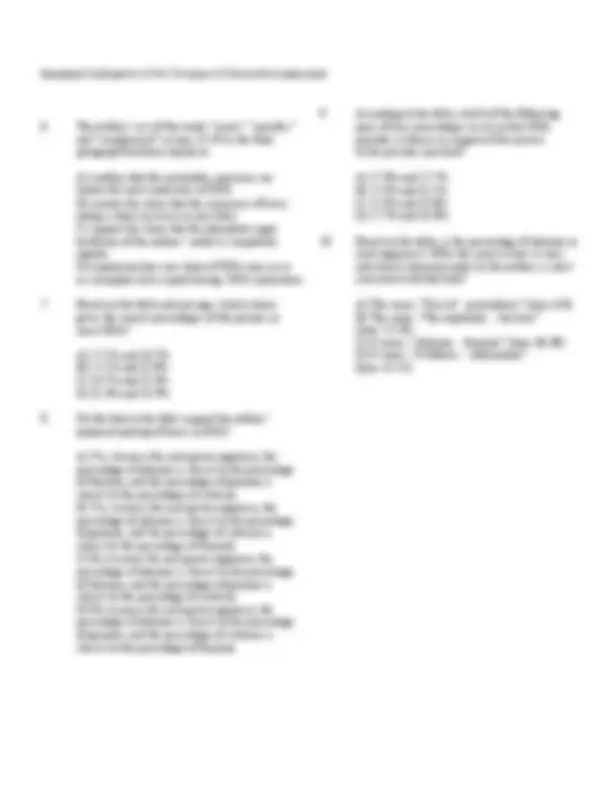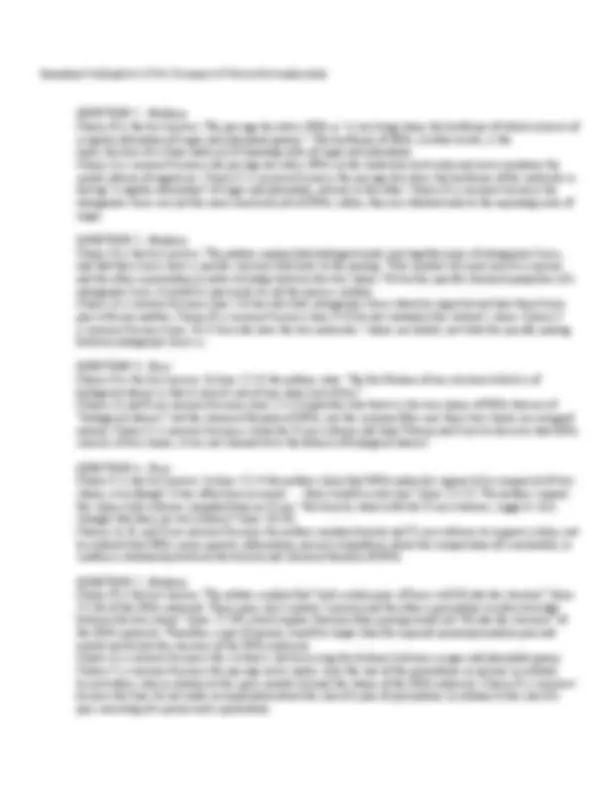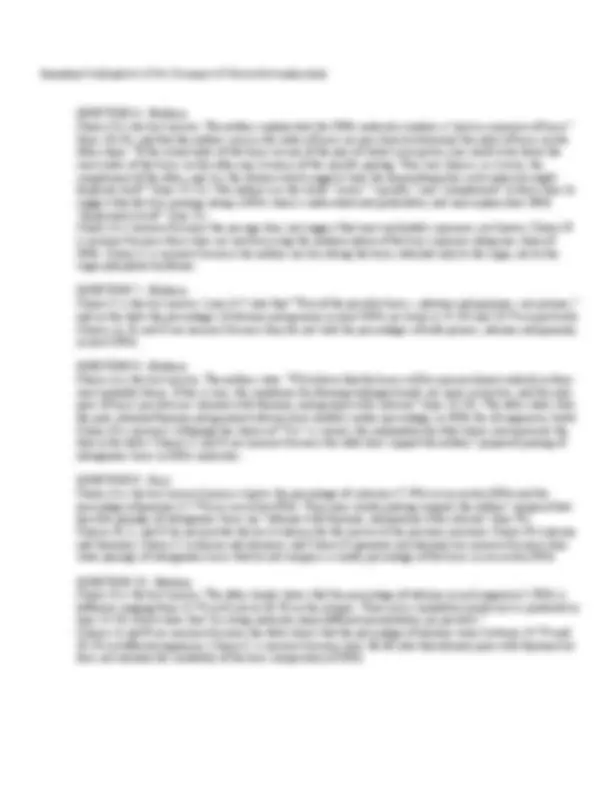





Study with the several resources on Docsity

Earn points by helping other students or get them with a premium plan


Prepare for your exams
Study with the several resources on Docsity

Earn points to download
Earn points by helping other students or get them with a premium plan
Community
Ask the community for help and clear up your study doubts
Discover the best universities in your country according to Docsity users
Free resources
Download our free guides on studying techniques, anxiety management strategies, and thesis advice from Docsity tutors
Watson and Crick's discovery of the structure of DNA using evidence from Rosalind Franklin and R.G. Gosling's X-ray crystallography diagrams and Erwin Chargaff's data on base composition. The authors explain how the specific pairing of nitrogenous bases (adenine with thymine and guanine with cytosine) is crucial for the formation of hydrogen bonds and the precise sequence of bases carrying genetic information.
Typology: Study Guides, Projects, Research
1 / 5

This page cannot be seen from the preview
Don't miss anything!




Questions 1-10 are based on the following passage and supplementary material. This passage is adapted from J. D. Watson and F. H. C. Crick, “Genetical Implications of the Structure of Deoxyribonucleic Acid.” ©1953 by Nature Publishing Group. Watson and Crick deduced the structure of DNA using evidence from Rosalind Franklin and R. G. Gosling’s X-ray crystallography diagrams of DNA and from Erwin Chargaff’s data on the base composition of DNA. The chemical formula of deoxyribonucleic acid (DNA) is now well established. The molecule is a very long chain, the backbone of which consists of a regular alternation of sugar and phosphate groups. To each 5 sugar is attached a nitrogenous base, which can be of four different types. Two of the possible bases— adenine and guanine—are purines, and the other two— thymine and cytosine—are pyrimidines. So far as is known, the sequence of bases along the chain is 10 irregular. The monomer unit, consisting of phosphate, sugar and base, is known as a nucleotide. The first feature of our structure which is of biological interest is that it consists not of one chain, but of two. These two chains are both coiled around a 15 common fiber axis. It has often been assumed that since there was only one chain in the chemical formula there would only be one in the structural unit. However, the density, taken with the X-ray evidence, suggests very strongly that there are two. 20 The other biologically important feature is the manner in which the two chains are held together. This is done by hydrogen bonds between the bases. The bases are joined together in pairs, a single base from one chain being hydrogen-bonded to a single base from 25 the other. The important point is that only certain pairs of bases will fit into the structure. One member of a pair must be a purine and the other a pyrimidine in order to bridge between the two chains. If a pair consisted of two purines, for example, there would not 30 be room for it. We believe that the bases will be present almost entirely in their most probable forms. If this is true, the conditions for forming hydrogen bonds are more restrictive, and the only pairs of bases possible 35 are: adenine with thymine, and guanine with cytosine. Adenine, for example, can occur on either chain; but when it does, its partner on the other chain must always be thymine. The phosphate-sugar backbone of our model is 40 completely regular, but any sequence of the pairs of bases can fit into the structure. It follows that in a long
molecule many different permutations are possible, and it therefore seems likely that the precise sequence of bases is the code which carries the genetical 45 information. If the actual order of the bases on one of the pair of chains were given, one could write down the exact order of the bases on the other one, because of the specific pairing. Thus one chain is, as it were, the complement of the other, and it is this feature which 50 suggests how the deoxyribonucleic acid molecule might duplicate itself.
The table shows, for various organisms, the percentage of each of the four types of nitrogenous bases in that organism’s DNA.
A) only very long chains of DNA can be taken from an organism with a spinal column. B) the main structure of a chain in a DNA molecule is composed of repeating units. C) a chain in a DNA molecule consists entirely of phosphate groups or of sugars. D) nitrogenous bases form the main structural unit of DNA.
A) Lines 4-6 (“To each... types”) B) Lines 8-10 (“So far... irregular”) C) Lines 22-25 (“The bases... other”) D) Lines 26-28 (“One member... chains”)
A) The chemical formula of DNA B) The common fiber axis C) The X-ray evidence D) DNA consisting of two chains
A) establish that DNA is the molecule that carries the genetic information. B) present an alternate hypothesis about the composition of a nucleotide. C) provide support for the authors’ claim about the number of chains in a molecule of DNA. D) confirm the relationship between the density of DNA and the known chemical formula of DNA.
A) of purines would be larger than the space between a sugar and a phosphate group. B) of purines would be larger than a pair consisting of a purine and a pyrimidine. C) of pyrimidines would be larger than a pair of purines. D) consisting of a purine and a pyrimidine would be larger than a pair of pyrimidines.
QUESTION 1 - Medium Choice B is the best answer. The passage describes DNA as “a very long chain, the backbone of which consists of a regular alternation of sugar and phosphate groups.” The backbone of DNA, in other words, is the main structure of a chain made up of repeating units of sugar and phosphate. Choice A is incorrect because the passage describes DNA on the molecular level only and never mentions the spinal column of organisms. Choice C is incorrect because the passage describes the backbone of the molecule as having “a regular alternation” of sugar and phosphate, not one or the other. Choice D is incorrect because the nitrogenous bases are not the main structural unit of DNA; rather, they are attached only to the repeating units of sugar.
QUESTION 2 - Medium Choice D is the best answer. The authors explain that hydrogen bonds join together pairs of nitrogenous bases, and that these bases have a specific structure that leads to the pairing: “One member of a pair must be a purine and the other a pyrimidine in order to bridge between the two chains.”Given the specific chemical properties of a nitrogenous base, it would be inaccurate to call the process random. Choice A is incorrect because lines 5-6 describe how nitrogenous bases attach to sugar but not how those bases pair with one another. Choice B is incorrect because lines 9-10 do not contradict the student’s claim. Choice C is incorrect because lines 23-25 describe how the two molecules’ chains are linked, not what the specific pairing between nitrogenous bases is.
QUESTION 3 - Easy Choice D is the best answer. In lines 12-14 the authors state: “the first feature of our structure which is of biological interest is that it consists not of one chain, but of two.” Choices A and B are incorrect because lines 12-14 explicitly state that it is the two chains of DNA that are of “biological interest,” not the chemical formula of DNA, nor the common fiber axis those two chains are wrapped around. Choice C is incorrect because, while the X-ray evidence did help Watson and Crick to discover that DNA consists of two chains, it was not claimed to be the feature of biological interest.
QUESTION 4 - Easy Choice C is the best answer. In lines 12-14 the authors claim that DNA molecules appear to be comprised of two chains, even though “it has often been assumed... there would be only one” (lines 15-17). The authors support this claim with evidence compiled from an X-ray: “the density, taken with the X-ray evidence, suggests very strongly that there are two [chains]” (lines 18-19). Choices A, B, and D are incorrect because the authors mention density and X-ray evidence to support a claim, not to establish that DNA carries genetic information, present a hypothesis about the composition of a nucleotide, or confirm a relationship between the density and chemical formula of DNA.
QUESTION 5 - Medium Choice B is the best answer. The authors explain that “only certain pairs of bases will fit into the structure” (lines 25-26) of the DNA molecule. These pairs must contain “a purine and the other a pyrimidine in order to bridge between the two chains” (lines 27-29), which implies that any other pairing would not “fit into the structure” of the DNA molecule. Therefore, a pair of purines would be larger than the required purine/pyrimidine pair and would not fit into the structure of the DNA molecule. Choice A is incorrect because this section is not discussing the distance between a sugar and phosphate group. Choice C is incorrect because the passage never makes clear the size of the pyrimidines or purines in relation to each other, only in relation to the space needed to bond the chains of the DNA molecule. Choice D is incorrect because the lines do not make an implication about the size of a pair of pyrimidines in relation to the size of a pair consisting of a purine and a pyrimidine.
QUESTION 6 - Medium Choice D is the best answer. The authors explain how the DNA molecule contains a “precise sequence of bases” (lines 43-44), and that the authors can use the order of bases on one chain to determine the order of bases on the other chain: “If the actual order of the bases on one of the pair of chains were given, one could write down the exact order of the bases on the other one, because of the specific pairing. Thus one chain is, as it were, the complement of the other, and it is this feature which suggests how the deoxyribonucleic acid molecule might duplicate itself ” (lines 45-51). The authors use the words “exact,” “specific,” and “complement” in these lines to suggest that the base pairings along a DNA chain is understood and predictable, and may explain how DNA “duplicate[s] itself ” (line 51). Choice A is incorrect because the passage does not suggest that most nucleotide sequences are known. Choice B is incorrect because these lines are not discussing the random nature of the base sequence along one chain of DNA. Choice C is incorrect because the authors are describing the bases attached only to the sugar, not to the sugar-phosphate backbone.
QUESTION 7 - Medium Choice C is the best answer. Lines 6-7 state that “Two of the possible bases—adenine and guanine—are purines,” and on the table the percentages of adenine and guanine in yeast DNA are listed as 31.3% and 18.7% respectively. Choices A, B, and D are incorrect because they do not state the percentages of both purines, adenine and guanine, in yeast DNA.
QUESTION 8 - Medium Choice A is the best answer. The authors state: “We believe that the bases will be present almost entirely in their most probable forms. If this is true, the conditions for forming hydrogen bonds are more restrictive, and the only pairs of bases possible are: adenine with thymine, and guanine with cytosine” (lines 31-35). The table shows that the pairs adenine/thymine and guanine/cytosine have notably similar percentages in DNA for all organisms listed. Choice B is incorrect. Although the choice of “Yes” is correct, the explanation for that choice misrepresents the data in the table. Choices C and D are incorrect because the table does support the authors’ proposed pairing of nitrogenous bases in DNA molecules.
QUESTION 9 - Easy Choice A is the best answer because it gives the percentage of cytosine (17.3%) in sea urchin DNA and the percentage of guanine (17.7%) in sea urchin DNA. Their near similar pairing supports the authors’ proposal that possible pairings of nitrogenous bases are “adenine with thymine, and guanine with cytosine” (line 35). Choices B, C, and D do not provide the best evidence for the answer to the previous question. Choice B (cytosine and thymine), Choice C (cytosine and adenine), and Choice D (guanine and adenine) are incorrect because they show pairings of nitrogenous bases that do not compose a similar percentage of the bases in sea urchin DNA.
QUESTION 10 - Medium Choice D is the best answer. The table clearly shows that the percentage of adenine in each organism’s DNA is different, ranging from 24.7% in E.coli to 33.2% in the octopus. That such a variability would exist is predicted in lines 41-43, which states that “in a long molecule many different permutations are possible.” Choices A and B are incorrect because the table shows that the percentage of adenine varies between 24.7% and 33.2% in different organisms. Choice C is incorrect because lines 36-38 state that adenine pairs with thymine but does not mention the variability of the base composition of DNA.